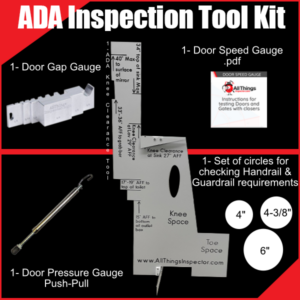
Designing commercial buildings with ADA compliance in mind is not just a regulatory obligation; it’s a commitment to justice and equality for all. From concert venues to retail spaces, attention to detail, such as the proper placement of handrails, plays a pivotal role in creating accessible environments. ADA inspections serve as an essential step in validating that these designs meet enforced standards, ensuring all individuals can navigate spaces with dignity. Understanding how to implement these guidelines effectively can seem overwhelming, but it doesn’t have to be. Each area of design, from restrooms to outdoor spaces, offers unique challenges and opportunities for inclusivity. Keep reading to uncover the essential standards that will help create accessible and compliant commercial buildings.
In evaluating the essential factors for ADA compliance in commercial buildings, I find it critical to grasp the fundamentals outlined by the Americans With Disabilities Act (ADA) ada inspections. This law, enforced by the United States Department of Justice, mandates that all individuals, regardless of disability, have access to public spaces. As I navigate the specifics, I identify key areas that must comply with ADA requirements, focusing particularly on the design of accessible routes, which serve as vital pathways for individuals who rely on vehicles for transportation. This consideration is not just about adhering to regulations; it shapes the overall experience and functionality of built environments, fostering inclusivity.
The Americans With Disabilities Act (ADA) significantly impacts various service areas in our society, including commercial spaces. I often reflect on the importance of ada inspections accessible features, like ensuring that every restroom has a properly equipped paper towel machine, which enables all individuals to maintain hygiene without barriers. Experiences at places like an amusement park can become frustrating for those facing discrimination if the pathways, such as sidewalks, are not designed to accommodate diverse mobility needs.
When assessing areas in a commercial building that must meet ADA requirements, I focus on specific elements that influence accessibility for all visitors. Restrooms, entrances, and pathways need to align with the latest building code to ensure seamless navigation for individuals using mobility aids. During construction, I advocate for designs that prioritize patient access, as creating inclusive environments not only enhances usability but also reflects a commitment to community values.
Incorporating accessible routes into design plans for commercial buildings, like a convention center, is vital for creating inclusive environments. As a landlord, I understand that ensuring these pathways meet ADA standards isn’t just about compliance; it’s also a key factor in lease agreements and overall tenant satisfaction. By considering accessibility in the contract terms, we can promote a welcoming atmosphere that also positively impacts tax assessments, enhancing the value of the property.
As I delve deeper into the critical standards set by the ADA, I realize that adhering to guidelines for accessible parking and pathways is foundational for facilitating access. It’s essential to ensure that spaces designated for individuals with intellectual disabilities are appropriately located and well-marked. Furthermore, the requirements for doorways and entry points play a significant role in ensuring all visitors can enter without obstruction. I also find that navigating interior accessibility standards, including the placement of elevators and ensuring service animal access, significantly enhances the usability of a structure. For instance, a law firm must focus on these elements to accommodate clients’ needs fully and ensure their premises are welcoming to everyone.
When I assess the layout of accessible parking spaces, I recognize the importance of strategic placement. Ensuring these spaces are close to building entrances helps minimize the distance for individuals with mobility challenges. I always prioritize the design of these areas to not only meet ADA guidelines but also to maintain fire safety protocols, particularly in buildings that house sensitive items like computer hardware or law offices.
Creating clear pathways from accessible parking areas to entrances is essential for efficient wayfinding. I focus on ensuring that these routes are well-marked and free of obstructions, creating a smooth transition into the building. For legal professionals, such as lawyers, this attention to detail enhances the client experience, making sure everyone feels welcome and secure as they navigate the space.
In my assessment of doorway and entry point requirements, I emphasize the necessity of ensuring that widths accommodate ADA compliance standards, typically set at a minimum of 32 inches. This measurement facilitates easy access for individuals using mobility aids. Furthermore, I pay special attention to features such as automatic doors, which greatly enhance safety and functionality in environments such as a factory setting where efficient movement is essential.
As I engage with the specifics of navigating interior accessibility standards, I realize the importance of adhering to the regulations set forth by the Americans with Disabilities Act of 1990. It’s essential that all elements within a dwelling conform to the pertinent code of federal regulations, ensuring accessibility across various jurisdictions. I often find myself referencing court rulings to better understand how these standards are interpreted and enforced, reinforcing the necessity of creating inclusive environments for all individuals.
When I evaluate the layout of ADA compliant restrooms in commercial buildings, I focus on ensuring wheelchair accessibility as a top priority. The design must accommodate reasonable accommodation principles, allowing for easy navigation within the space. In addition, I pay close attention to specifications for fixtures and accessories, such as accessible toilets and sinks, to ensure they meet regulatory standards. Furthermore, I understand that providing privacy and usability for all users is vital—no one should feel uncomfortable when using the facilities. A well-thought-out restroom design can prevent the failure of meeting ADA guidelines, which could inadvertently lead to a negative experience for customers, similar to the frustration of waiting in line at a cash register that lacks sufficient space for all individuals.
In designing layouts for wheelchair accessibility, I place significant emphasis on compliance with occupancy requirements as mandated by the Architectural Barriers Act of 1968. For commercial property, ensuring ample space around fixtures allows individuals, particularly those undergoing physical therapy, to navigate the restroom comfortably. This consideration not only reflects a commitment to accessibility but also optimizes the functionality of the space, enabling an effective use of the entire facility’s design as an engine for inclusivity.
As I design fixtures and accessories for ADA compliant restrooms, I ensure that every component aligns with section 504 of the Rehabilitation Act. This not only covers basic accessibility features but also considers the “safe harbor” provisions under the international building code to minimize legal risk. Understanding that introducing these elements may involve a fee presents a necessary expense, but it ultimately fosters a welcoming and functional environment for all users.
To ensure privacy and usability for all users in a bathroom, I prioritize adherence to the American National Standards Institute (ANSI) guidelines during the design phase. This means considering thoughtful layouts that provide adequate space between stalls, while also ensuring that the floor path is clear and accessible for everyone. Achieving certification through these standards is not just about meeting regulations; it’s about creating a welcoming environment where every individual can feel comfortable and secure while using the facilities.
Focusing on accessible workspaces and common areas requires an intentional approach to design that considers a wide range of needs. As I think about the layout of office spaces, I highlight the importance of ergonomics and mobility, ensuring that pathways allow easy movement for all individuals, particularly those using mobility aids. Meeting rooms should be integrated with features that welcome everyone, including adequately spaced seating arrangements and accessible tables. I also emphasize the need to make amenities like restrooms user-friendly, with features such as accessible urinals and appropriately designed toilet seats. In addressing facilities with stairs, I advocate for incorporating ramps and lifts to ensure seamless access across all levels of the property, fostering an inclusive environment where everyone feels valued and comfortable.
In my experience, optimizing office layouts with a focus on ergonomics and mobility significantly enhances the built environment’s usability. For instance, ensuring that essential features, like a drinking fountain, are strategically placed allows everyone easy access without barriers. I often document my designs to mitigate the risk of potential lawsuits, demonstrating a commitment to creating inclusive spaces that consider the diverse needs of all individuals who interact with the workspace.
While designing meeting rooms, I focus on integrating accessible features that ensure all participants can engage fully. Incorporating ADA compliant elements not only enhances the experience for individuals with disabilities, but it also aligns with broader goals in health care and employment sectors, promoting inclusivity. During renovation projects, I take particular care to respect the unique characteristics of buildings on the National Register of Historic Places while ensuring that regulatory standards are met.
When I focus on making amenities and services accessible to everyone, I pay close attention to the height of fixtures, ensuring they are within reach for all passengers, including those with mobility challenges. In designing spaces like restrooms and recreation areas, I prioritize incorporating grab bars strategically placed alongside toilets and bathing facilities to enhance safety and usability. I also consider aisle widths and clear pathways so that individuals can navigate comfortably and safely, contributing to a more inclusive environment in commercial buildings.
As I focus on outdoor spaces and landscaping, I recognize the importance of implementing policies that address accessibility in every aspect. From the design of parking lots and drop-off areas to the creation of accessible routes and paths, I understand that every detail matters. Ensuring that curbs are designed to facilitate movement is essential, and I make it a priority to incorporate features that guide individuals seamlessly. Additionally, I explore how landscaping can enhance accessibility while maintaining aesthetic value, creating room for everyone to navigate freely and comfortably. As an architect, aligning these elements with ADA standards is fundamental for fostering inclusivity in commercial environments.
When I assess the accessibility of parking lots and drop-off areas, I prioritize clear signage and well-marked pathways. It’s essential to position accessible parking spaces close to building entrances to reduce travel distance for individuals with mobility challenges. I also recognize the importance of ensuring these areas are well-lit and free of obstacles, enhancing safety and usability for everyone.
As I design outdoor spaces, I focus on creating accessible routes that connect various areas effectively. I ensure that pathways are wide enough to accommodate mobility aids and that surfaces are smooth and stable, minimizing the risk of trips and falls. Incorporating tactile and visual cues along these routes not only assists individuals with disabilities but also enhances the overall user experience within the environment.
As I design landscaping for commercial buildings, I prioritize accessibility to ensure that all individuals can enjoy outdoor spaces comfortably. By selecting plants and materials that require minimal maintenance while promoting navigable paths, I create an inviting environment that accommodates various mobility needs. I focus on integrating features like raised beds and sensory gardens, which not only enhance visual appeal but also provide inclusive experiences for everyone who visits.
Addressing ADA compliance in existing buildings requires a strategic approach that starts with a thorough assessment of the current structure. I assess areas where modifications are needed, identifying any barriers that may hinder accessibility for all individuals. Following this evaluation, I meticulously plan and execute renovations aimed at enhancing compliance, ensuring that each change aligns with regulatory standards. Moreover, I emphasize the importance of continuous evaluation and maintenance to sustain an accessible environment. By regularly inspecting facilities and updating features as necessary, I can help ensure that buildings remain welcoming and functional for everyone who interacts with them.
When I evaluate existing structures for ADA compliance, I start by examining the entrances, pathways, and restrooms to identify any barriers that could restrict access for individuals with disabilities. This assessment often involves measuring door widths and checking the condition of ramps or elevators to ensure they meet current standards. Each element must align with accessibility guidelines, as even small modifications can significantly improve usability and create a more welcoming environment for everyone.
When I undertake the task of planning and executing ADA compliant renovations, I begin by prioritizing the specific needs of the building’s users. I focus on crafting practical solutions that address any identified barriers while ensuring minimal disruption to the existing operations. This hands-on approach not only maintains compliance but also fosters an inclusive atmosphere that reflects my commitment to accessibility for all individuals who frequent the space.
In my experience, implementing a continuous evaluation and maintenance plan for accessibility is fundamental in any commercial building. Regular inspections help me identify any areas where accessibility might be compromised over time, allowing for timely adjustments. By prioritizing this ongoing commitment, I ensure that the space remains welcoming and functional for all individuals, reflecting my dedication to inclusive environments.
Achieving ADA compliance in commercial building designs ensures equal access for all individuals, fostering inclusivity and dignity. Prioritizing accessible features such as restrooms, pathways, and workspaces enhances the overall functionality of a building. By adhering to guidelines, designers and builders not only meet legal standards but also demonstrate a commitment to community values. Implementing these standards creates welcoming environments that benefit everyone who interacts with the space.



Measuring door pressure is acting in compliance with building regulations, like the Americans with Disabilities Act (ADA). It’s an important step in ensuring accessibility, safety

When talking about building safety, the first things that come to mind are fire alarms, emergency exits and security systems. Meanwhile, the one tool that